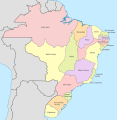Federative units of Brazil
The federative units of Brazil (Portuguese: unidades federativas do Brasil) are subnational entities with a certain degree of autonomy (self-government, self-regulation, and self-collection) and endowed with their own government and constitution, which together form the Federative Republic of Brazil. There are 26 states (estados) and one federal district (distrito federal). The states are generally based on historical, conventional borders which have developed over time. The states are divided into municipalities, while the Federal District assumes the competences of both a state and a municipality.
Federative units of Brazil
Unidades federativas do Brasil
5,761 km2 (2,224 sq mi) (Federal District) – 1,559,168 km2 (601,998 sq mi) (Amazonas)
![1534 Captaincies of Brazil[a]](http://upload.wikimedia.org/wikipedia/commons/thumb/0/00/Novo_mapa_Capitanias.jpg/84px-Novo_mapa_Capitanias.jpg)
![1709–1720/1761–1779 Expansion and mergers[b]](http://upload.wikimedia.org/wikipedia/commons/thumb/7/78/Brazil_in_1709.svg/121px-Brazil_in_1709.svg.png)

![1889 States at the start of the republic[c]](http://upload.wikimedia.org/wikipedia/commons/thumb/e/ee/Brazil_in_1889.svg/121px-Brazil_in_1889.svg.png)

